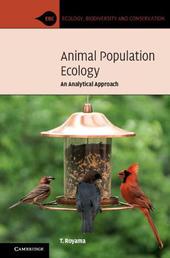
|
Animal Population Ecology: An Analytical Approach
Paperback / softback
Main Details
| Title |
Animal Population Ecology: An Analytical Approach
|
| Authors and Contributors |
By (author) T. Royama
|
| Series | Ecology, Biodiversity and Conservation |
|---|
| Physical Properties |
| Format:Paperback / softback | | Pages:286 | | Dimensions(mm): Height 227,Width 151 |
|
| Category/Genre | Applied ecology
Management of land and natural resources |
|---|
| ISBN/Barcode |
9781108948166
|
| Classifications | Dewey:591.788 |
|---|
| Audience | | Professional & Vocational | | Tertiary Education (US: College) | |
|---|
| Illustrations |
Worked examples or Exercises
|
|
Publishing Details |
| Publisher |
Cambridge University Press
|
| Imprint |
Cambridge University Press
|
| Publication Date |
22 April 2021 |
| Publication Country |
United Kingdom
|
Description
Animal population ecology comprises the study of variations, regulation, and interactions of animal populations. This book discusses the fundamental notions and findings of animal populations on which most of the ecological studies are based. In particular, the author selects the logistic law of population growth, the nature of competition, sociality as an antithesis of competition, the mechanism underlying the regulation of populations, predator-prey interaction processes, and interactions among closely related species competing over essential resources. These are the notions that are considered to be well-established facts or principles and are regularly taught at ecology classes or introduced in standard textbooks. However, the author demonstrates that these notions are still inadequately understood, or even misunderstood, creating myths that would misguide ecologists in carrying out their studies. He delves deeply into those notions to reveal their real nature and draws a road map to the future development of ecology.
Author Biography
Tom Royama is well known for his field studies of Great Tit and Spruce Budworm, and his contribution to theoretical ecology through the innovative application of stochastic processes. His previous book, Analytical Population Dynamics (1992), had a significant impact on population ecology. He was also a recipient of a Gold Medal of Entomological Society of Canada in 1994.
Reviews'This would be a valuable text for quantitative ecology courses. While manageable for interested general readers, its emphasis on mathematical applications and predictive parameters would make it most useful in advanced courses as a source of real-world examples. Mathematicians, too, may find the text valuable for teaching modeling in general, to supplement econometric, demographic, and climate models.' J. Burger, Choice
|